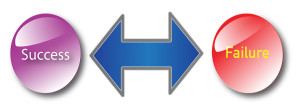The #1 Reason Why Businesses Fail at Salesforce Implementation and How to Avoid it

Salesforce® is the most valuable investment that many businesses will make this year.
A large percentage of the companies that adopt a Salesforce instance will choose to implement it without outside help. However, many of these businesses will fail for reasons beyond their control.
The #1 Reason Why Businesses Fail at Salesforce Implementation and How to Avoid it
We’ll let you in on a little secret: most GeauxPoint Salesforce work is in re-implementations. This means that the client unsuccessfully attempted to set up Salesforce themselves, and then later realized that maybe they need a little help.
Implementing a Salesforce instance without outside help is certainly possible and there’s tons of content out there to help DIY’ers. Still, missteps are frequent and costly.
The Most Common Failure Scenario: 3 Critical Mistakes to Avoid
About 70 percent of clients that approach GeauxPoint for Salesforce assistance have attempted and failed at a Salesforce self-installation. This equates to thousands of hours and dollars lost. In many cases, failed implementation can harm data systems, which then require laborious and expensive “unwinding.”
Why do so many business fail at implementation? Usually, they make the following three critical mistakes for Salesforce implementation:
 |
Critical Mistake #1: Procuring the Wrong Products or LicensesUsually, clients make first contact with software products like Salesforce-based solutions through marketing, such as on the Web or through a vendor at a conference. It’s not clear to them at this point what their options are. They only understand the potential benefits presented by the marketer. As a result, the client purchases licenses, overlays, and third-party apps that aren’t appropriate. |
 |
Critical Mistake #2: Jumping Into ImplementationRight after obtaining licensing, clients jump right into what seems the next logical step: implementation. The client may read and review some of the many guides available, but often times they improvise through most of the process. |
 |
Critical Mistake #3: Retroactively PlanningAt this point, obstacles begin to emerge, and it’s often too late to fix them. Clients slowly become aware of fundamental problems in their implementation strategy. They then deploy a series of Band-Aid fixes and outside applications that only make matters worse |
After these three mistakes, clients are usually faced with a choice: either abandon their Salesforce investment or perform a re-implementation with an expert.
STILL UNSURE? CLICK TO SEE GEAUXPOINT’S GUARANTEED SALESFORCE IMPLEMENTATION SOLUTION.
